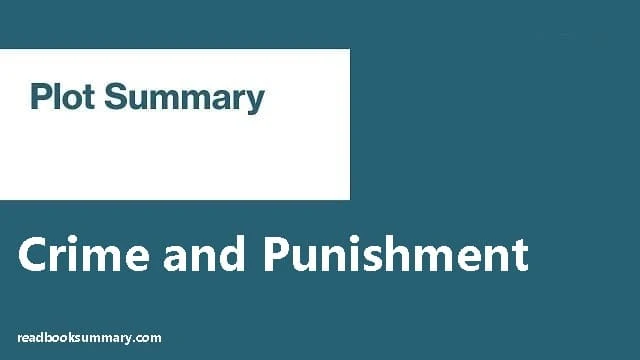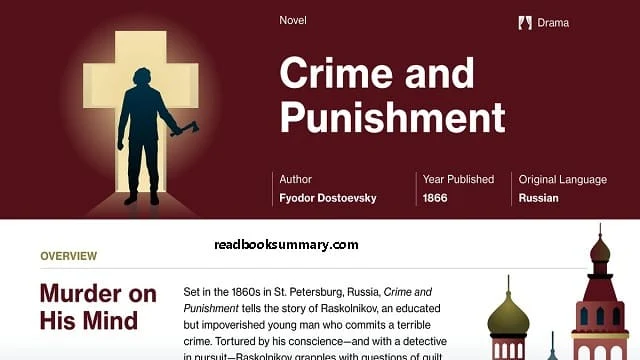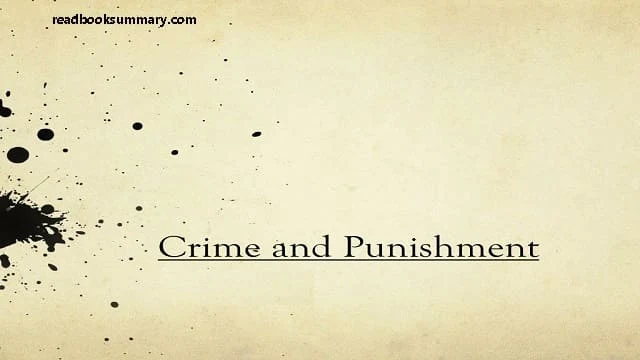Crime and Punishment Summary. it is a novel by the Russian author Fyodor Dostoevsky. It was first published in the literary journal The Russian Messenger in twelve monthly installments during 1866. It was later published in a single volume.
It is the second of Dostoyevsky's full-length novels following his return from ten years of exile in Siberia. Crime and Punishment is considered the first great novel of his mature period of writing. The novel is often cited as one of the supreme achievements in world literature.
 |
| Crime and Punishment Summary |
Crime and Punishment Summary
A poor, paranoid young student named Raskolnikov convinces himself that he is extraordinary. He develops a theory to suggest that the world’s most extraordinary men should be permitted to commit any crime in pursuit of the greater good of humanity. Raskolnikov lives in a tiny apartment, spends what little money he has on strange, altruistic causes, and plots some mysterious, terrible deed that will prove his superiority.
Finally, Raskolnikov decides to test his theory. He murders an elderly pawnbroker whom he considers a leech on society. He also murders the pawnbroker’s half-sister, who intrudes on the murder scene unexpectedly. Raskolnikov escapes the scene of the crime, but soon falls ill with a fever and spends several days unconscious in his tiny apartment. When Raskolnikov begins to recover, he learns that his sister Dunia plans to marry a pompous, wealthy man named Luzhin. Raskolnikov is furious, believing that Dunia is sacrificing her happiness on his behalf. When Luzhin comes to see Raskolnikov in Saint Petersburg, Raskolnikov erupts with anger and throws insults at his prospective brother-in-law.
Raskolnikov rises from his sick bed and sneaks out. He frantically reads the newspapers every day since the murders. When Raskolnikov runs into a police officer, he nearly confesses to the crimes—and his frantic ranting raises suspicions in the police department. Raskolnikov runs out of the police station and sees his drinking buddy, a clerk named Marmeladov, lying in the street fatally wounded by a stagecoach. Marmeladov is carried to the small apartment he shares with his family. Feeling sorry for the grieving family—particularly Marmeladov’s teenage daughter Sonia—Raskolnikov leaves behind all of his money to pay for Marmeladov’s funeral.
Raskolnikov is surprised to find his mother and sister on his doorstep. They have come to prepare for Dunia’s marriage to Luzhin. Enraged, Raskolnikov forbids his sister from marrying Luzhin.
Dunia’s former employer, a rich man named Svidrigailov, arrives in Saint Petersburg. His extramarital pursuit of Dunia caused a scandal that nearly ruined her reputation in the provinces. Now that Svidrigailov’s wife is dead, he has come to Saint Petersburg in the hopes that he can seduce Dunia.
Memories of the murders plague Raskolnikov. When he discovers that the local police magistrate Porfiry has begun to interview all of the pawnbroker’s clients, Raskolnikov requests the return of his own pawned items. His strange conversation with Porfiry only leads to more suspicion. Afterward, while preparing for Marmeladov’s funeral, Raskolnikov and Sonia prepare talk about religion and morality. Raskolnikov pities Sonia, who has been forced into prostitution by her poverty. Raskolnikov decides to tell her who murdered the two women, promising to return the next day.
Porfiry interviews Raskolnikov again. Though he is certain that Raskolnikov is the murderer, he is not yet able to provide proof. Raskolnikov visits Sonia and tells her what he did. In the room next door, Svidrigailov eavesdrops on the conversation and learns the truth. Later, Svidrigailov tries to use his knowledge of the confession to blackmail Dunia into marriage. She refuses him, accuses him of murdering his wife, and she tries to shoot him in the head. She misses, but Svidrigailov realizes that Dunia will never love him. He lets her go and, the next day, he commits suicide.
After man is arrested after falsely confessing to the murders, Porfiry visits Raskolnikov and reveals that he knows the truth. However, he wishes to give Raskolnikov time to make a sincere confession. After an anxious night and with support from Sonia, Raskolnikov visits the police station and confesses. He is sentenced to a penal colony in Siberia, where Sonia joins him. While there, he pieces his life back together.
You may also like to read: Looking for Alaska Book Summary
Crime and Punishment Themes
Crime, Morality, and Guilt: This central theme revolves around Raskolnikov's justification for his crime and his subsequent descent into guilt and paranoia. Through internal monologues and interactions with other characters, the novel explores the nature of morality, the impact of crime on the perpetrator and society, and the path to redemption.
Punishment and Suffering: Punishment in the novel extends beyond legal consequences. Raskolnikov experiences psychological torment, isolation, and fear, questioning the purpose of his suffering and its potential to lead to redemption.
Alienation and Redemption: Raskolnikov's pride and intellectual arrogance isolate him from society, contributing to his crime and deepening his suffering. The possibility of redemption is explored through his interactions with characters like Sonia Marmeladova, who embodies compassion and forgiveness.
Poverty and Social Injustice: The harsh realities of poverty and social inequality in 19th-century Russia serve as a backdrop for the story. Dostoevsky portrays the desperation and vulnerability of marginalized individuals, prompting readers to consider the impact of societal structures on individual choices and actions.
Religious Faith and Morality: The contrasting perspectives of characters like Raskolnikov, who struggles with faith, and Sonia, who finds solace in Christian belief, raise questions about the role of religion in shaping morality and offering hope for redemption.
Free Will and Determinism: The novel explores the tension between free will and the influence of social and psychological factors on individual choices. Raskolnikov's actions and their consequences spark debate about the extent to which individuals are responsible for their choices and their destinies.
Madness and Intoxication: The blurred lines between sanity and madness are reflected in Raskolnikov's feverish state and hallucinations. He questions his own sanity and grapples with the intoxication of his ideas and actions.
Money and Power: The desire for money and the allure of power play a significant role in Raskolnikov's motivations. The novel critiques societal values that prioritize wealth and social status, highlighting their potential to corrupt individuals and distort their perspectives.
Love and Compassion: The theme of love and compassion emerges through characters like Sonia, who displays unconditional love and forgiveness towards Raskolnikov. This love serves as a catalyst for his transformation and potential redemption.
Family and Relationships: The complex dynamics within Raskolnikov's family and his interactions with characters like Dunya and Svidrigailov shed light on the influence of family relationships on individual choices and moral development.
 |
| crime and punishment analysis |
 |
| crime and punishment synopsis |
 |
| crime and punishment plot summary |
 |
| crime and punishment chapter summary |
 |
| dostoevsky crime and punishment summary |
 |
| fyodor dostoevsky crime and punishment summary |
Questions and Answers about Crime and Punishment Plot
What is the main summary of Crime and Punishment? Raskolnikov, a former student, lives in poverty and chaos in St. Petersburg. He decides—through contradictory theories, including utilitarian morality and the belief that extraordinary people have the “right to transgress”—to murder Alyona Ivanovna, an elderly pawnbroker.
How does Crime and Punishment end? Crime and Punishment ends with the promise of a new story. The novel's epilogue details how Raskolnikov, after confessing his crime of murdering the old pawnbroker and her sister, is tried in court. Because of his many selfless deeds (such as rescuing orphans), he is given a sentence of eight years in Siberia.
What does Crime and Punishment represent? It represents the state of society, with all of its inequalities, prejudices, and deficits. But it also represents Raskolnikov's delirious, agitated state as he spirals through the novel toward the point of his confession and redemption.
What is the moral lesson of Crime and Punishment? To go wrong in your own way is better than to go right in someone else's.
What is the main conflict in Crime and Punishment? In Fyodor Dostoevsky's Crime and Punishment, the main character Raskolnikov's most obvious conflict is with the people he murders, but the most profound conflicts are with himself as he learns to deal with the guilt associated with his crime.
Is Crime and Punishment difficult to read? Unlike other classics I've read, this was very easy to read, with minimal use of old style language and maybe it's because of this particular translated English version that I enjoyed this book so much. Raskolnikov is initially an unlikeable character.
What are the 4 explanations of crime? While there are many different sociological theories about crime, there are four primary perspectives about deviance: Structural Functionalism, Social Strain Typology, Conflict Theory, and Labeling Theory.
Is Crime and Punishment a love story? Yes, Crime and Punishment includes two romances. The main romance of the story is between Rodion Raskolnikov and Sonia Marmeladova. Raskolnikov murdered Sonia's friend Lizaveta and helped Sonia's family; Sonia is a young woman who turned to prostitution to save her stepsiblings, as her father drinks up all their money.
What is the climax of the Crime and Punishment? The climax of Crime and Punishment happens very near the beginning of the novel with the murder of the old pawnbroker and her sister, leaving much of the novel to consideration of the action and the declining mental state of Raskolnikov.
Why did Raskolnikov commit the crime? First, he says he killed the old lady because he was poor and needed money. This motive is the social justification from poverty. Then he argues that he wished to benefit society, that the old woman was useless and would have let her money rot. This motive is utilitarian.
What were the three main concepts of on crimes and punishments? Beccaria's highly influential work is organized around three central ideas relating to crime and punishment: the social contract, the value of science, and a strong belief in progress.
Who is the protagonist in Crime and Punishment? Rodion Raskolnikov, fictional character who is the protagonist of the novel Crime and Punishment (1866) by Fyodor Dostoyevsky. An impoverished student who murders a pawnbroker and her stepsister, Raskolnikov embodies the author's belief that salvation is possible only through atonement.
What is the conflict theory of punishment? The conflict theory of deviance posits that deviance is punished more severely for those with less power, or for those who attempt to interfere with capitalism. People are often labeled as deviant based on their low level of power.
Why is it important to read Crime and Punishment? Other than being a deep study into the experience of crime and its understanding, the novel also blends together with flowing ease the political, social and religious themes and undertones that color that understanding.
Is Crime and Punishment a masterpiece? Crime and Punishment (1866) is considered one of the greatest masterpieces of Russian literature.
Who is the villain in Crime and Punishment? Arkady Svidrigailov, simply known as Svidrigailov, is the main antagonist of Fyodor Dostoevsky's 1866 masterpiece Crime and Punishment.
Who is the main antagonist in Crime and Punishment? Porfiry Petrovich, He is Raskolnikov's primary antagonist, and, though he appears only occasionally in the novel, his presence is constantly felt. Read an in-depth analysis of Porfiry Petrovich.
What are the 3 crime theories? After three decades of research, three major psychological theories of crime have emerged: psychodynamic theory, behavioral theory and cognitive theory. Learning these criminology theories and how to put them into practice is a component of an online Bachelor of Science in Criminal Justice degree program.
What are 5 characteristics of crime?
- Causation.
- Harm.
- Legality.
- Punishment.
- Attendant circumstances.
What are the 5 steps of crime? The five basic steps in the crime analysis process include the collection, categorization, analysis, dissemination, and evaluation of information.
Who is the wife in Crime and Punishment? Katerina Ivanovna Marmeladov in Crime and Punishment.
